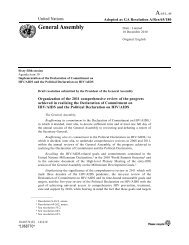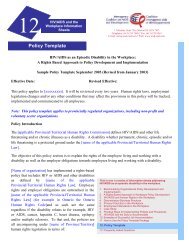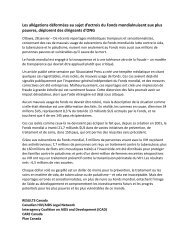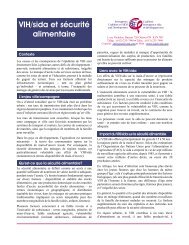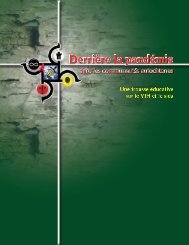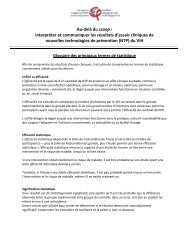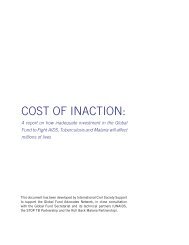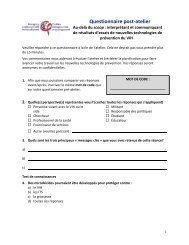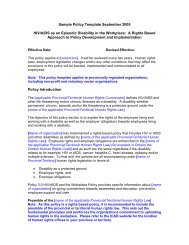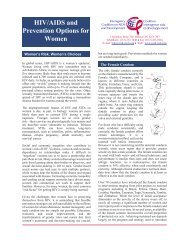Behind the Pandemic in Aboriginal Communities - Interagency ...
Behind the Pandemic in Aboriginal Communities - Interagency ...
Behind the Pandemic in Aboriginal Communities - Interagency ...
- No tags were found...
You also want an ePaper? Increase the reach of your titles
YUMPU automatically turns print PDFs into web optimized ePapers that Google loves.
through collaboration and shared responsibility.• For Aborig<strong>in</strong>al clients, a culturally safe health care environment considers <strong>the</strong>irhistorical context and honors who <strong>the</strong>y are now; it respects <strong>in</strong>teractions based onhumility and reciprocity and allows for a mutual exchange of <strong>in</strong>formation.• Relational care is an important Aborig<strong>in</strong>al approach to health care provision becauseit captures <strong>the</strong> physical, social, emotional, and spiritual dimensions of humanconnection.• Healthy care relationships foster positive outcomes for Aborig<strong>in</strong>al patients whoare access<strong>in</strong>g treatment and support, specifically when <strong>the</strong>y are HIV positive.Without healthy care relationships many patients discont<strong>in</strong>ue care because <strong>the</strong>y feelstigmatized or judged.• Respectful care relationships reflect <strong>the</strong> seven sacred teach<strong>in</strong>gs: love, respect,courage, honesty, wisdom, humility, and truth.• Relational care operates <strong>in</strong> an environment of open communication, acceptance,and accommodation of desired level of care of Aborig<strong>in</strong>al people liv<strong>in</strong>g with HIV. It ism<strong>in</strong>dful of both short and long term stages of care.Community HIV Competence:• The most effective responses to HIV are generated and guided by communitymembers.• HIV competent communities have knowledge and skills to prevent HIV <strong>in</strong>fections andto provide care and support to community members liv<strong>in</strong>g with and affected by HIV;safe social spaces to discuss <strong>in</strong>formation about HIV and what this looks like <strong>in</strong> <strong>the</strong>community; a sense of ownership over <strong>the</strong> problem of HIV <strong>in</strong> <strong>the</strong> community and asense of responsibility for f<strong>in</strong>d<strong>in</strong>g solutions; confidence <strong>in</strong> <strong>the</strong> community’s abilityto respond to HIV; a sense of solidarity; and access to relationships and resources tosupport <strong>the</strong> community to respond effectively.• Respond<strong>in</strong>g to HIV/AIDS is one of many priorities that test Aborig<strong>in</strong>al communitycapacity. Issues such as safe dr<strong>in</strong>k<strong>in</strong>g water, <strong>in</strong>sufficient fund<strong>in</strong>g allocations, grow<strong>in</strong>gpopulations, substandard hous<strong>in</strong>g, high unemployment, and resource extractivedevelopments are significant obstacles to health and well-be<strong>in</strong>g. These issuesrequire immediate attention.86Self-Determ<strong>in</strong>ation:• The important role of people liv<strong>in</strong>g with HIV – particularly young people – andaffected communities <strong>in</strong> HIV responses is enshr<strong>in</strong>ed <strong>in</strong> <strong>the</strong> Pr<strong>in</strong>ciple of GreaterInvolvement of People Liv<strong>in</strong>g with HIV (GIPA) from <strong>the</strong> Paris Declaration and <strong>the</strong>Declaration of Commitments from <strong>the</strong> United Nations Special Session on HIV/AIDS.• The active and mean<strong>in</strong>gful participation of people liv<strong>in</strong>g with HIV and affectedcommunities <strong>in</strong> HIV helps to ensure that programs, services, and policies areculturally competent, relevant and, <strong>in</strong> turn, effective; that <strong>the</strong>y streng<strong>the</strong>ncommunity HIV competence; and that <strong>the</strong>y nurture <strong>the</strong> resiliency of <strong>in</strong>volved<strong>in</strong>dividuals.• Aborig<strong>in</strong>al self-determ<strong>in</strong>ation occurs when <strong>the</strong> <strong>in</strong>dividual and community are <strong>in</strong>control of <strong>the</strong>ir situations. Self-determ<strong>in</strong>ation is a right that was all too often takenaway from <strong>the</strong> First Nations, Métis, and Inuit <strong>in</strong> Canada. <strong>Communities</strong> all overCanada have been and are assert<strong>in</strong>g <strong>the</strong>ir right to self-determ<strong>in</strong>ation <strong>in</strong> many ways<strong>in</strong>clud<strong>in</strong>g rega<strong>in</strong><strong>in</strong>g control of community <strong>in</strong>frastructures, land claims, treaties, and<strong>the</strong> delivery of health services through health transfers.



